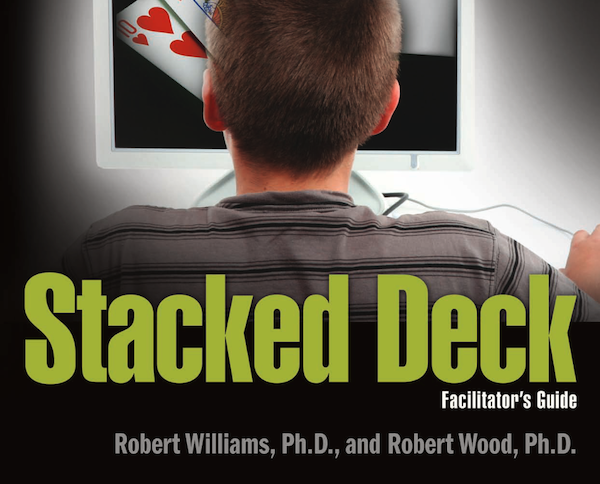One Problem Gambling Prevention Program Stands Above The Rest
“Unlike many prevention programs that advocate abstinence, we recognize that gambling is a normative activity,” Dr. Williams wrote. “Stacked Deck teaches students to evaluate gambling in the same way they evaluate whether to try out for the football team, ask someone on a date, etc."
4 min

About three-quarters of the United States has legalized sports betting in some capacity, and the various approaches to responsible gambling are as diverse as the states themselves. But mostly, the states have demonstrated different ways to underfund responsible gambling programs.
The National Association of Administrators for Disordered Gambling Services (NAADGS) found that on average, states spent $0.54 per capita on problem gambling. The median amount was $0.35, while most states spend less than $1 per capita. Only seven states spend more than $1 per capita.
By comparison, rehabs.com, a subsidiary of American Addiction Centers, Inc., found that average state expenditure on mental health services was just under $136 per capita. Problem gambling has far less funding directed toward it than substance abuse.
In states that properly fund problem gambling programs, most of the money supports treatment and helplines. Keith Whyte, the executive director of the National Council on Problem Gambling (NCPG), describes the problem gambling field as a triage model.
“Where we’d like to be is at the point where you have a more public health approach where you’re spending the bulk of your money on prevention of gambling addiction and education about responsible gambling,” said Whyte. “Then you spend a little bit less on treatment and [the] helpline because you’re slowing down the pipeline.”
At present, states are lacking adequate funding to implement a public health approach that includes education and prevention. Instead, state-based programs have focused on targeting people who are already struggling with gambling addiction.
“Right now, we’re spending little if any money in some states on prevention and education at all and so it’s the least cost-effective way to address a problem, but ethically, when you’ve got incredibly limited resources, when you’re a triage model, you’ve got to spend a lot of money on triage,” Whyte said.
However, there’s a glimmer of hope for a prevention program that can scale and service many different communities.
Stacked deck

Stacked Deck is a program for high schoolers that busts common gambling myths. Students learn how to evaluate commercial gambling offers and come to understand the details that make gambling offers both enticing and terrible deals.
“It’s shown a lot of promise in not just increasing awareness of problem gambling but actually in changing behavior, reducing risk factors, and increasing protective factors,” Whyte said. “A number of our Agility Grants that are funded by the NFL Foundation are using Stacked Deck and piloting it in more targeted populations.”
Those targeted populations include college students and minority groups who may be at greater risk for gambling disorders. There’s a potential versatility that could allow Stacked Deck to grow in a way that “Just Say No” couldn’t do.
“In the prevention field, one of the big lessons that everybody learned back in the ’80s was when Nancy Reagan came across the Just Say No program, it was intended for really young children, and unfortunately it became sort of a rubric for all sorts of drug prevention activities. But it was never intended for older teens, much less an adult audience,” Whyte said.
With such promise to scale, it’s worth understanding why Stacked Deck stands out among a country’s worth of prevention attempts.
Efficacy
Stacked Deck is designed to help young people retain information, instead of ticking a box for administrators.
Dr. Robert Williams, the creator of Stacked Deck, wrote in an email to Casino Reports that Stacked Deck offers five lessons “in contrast to the typical 1-2 lessons in other programs.” The lessons are also delivered over two weeks instead of all at once, improving retention.
However, the most powerful part of the Stacked Deck program is teaching students how to tell that gambling odds are unfavorable to bettors.
“Unlike many prevention programs that advocate abstinence, we recognize that gambling is a normative activity,” Dr. Williams wrote. “Stacked Deck teaches students to evaluate gambling in the same way they evaluate whether to try out for the football team, ask someone on a date, etc. In other words, evaluate what is being risked, what can be gained, and what are the odds of success. In this light, all commercial forms of gambling are bad long term bets.”
According to the Stacked Deck Facilitator’s Guide, the first three lessons in the program are:
- “Modern commercial gambling includes stacked odds that create the ‘house edge.'”
- “Gambling is an activity that can become addictive, and there are recognizable causes, risk factors, and signs of problem gambling.”
- “Two factors that contribute to problem gambling are lack of knowledge about gambling and misunderstanding about how gambling actually works.”
Unsurprisingly, the two most effective treatments for problem gambling are cognitive behavioral therapy and motivational interviewing. Both techniques are founded on the notions that ideas shape behaviors, and that people have the capacity to change.
Stacked Deck’s approach equips young people to change their understandings about problem gambling and learn how to avoid myths that keep people gambling beyond their budgets. It’s a promising program to watch as gambling becomes even more prevalent across the country.
[hfe_template id=’4095′]Readiness for expansion of online casinos
Efforts are underway in states including New York, Maryland, and Illinois to legalize online casinos. These states are among the highest per capita spenders on responsible gambling, but they’re still spending a fraction of the amounts allocated to substance abuse. Jurisdictions providing lesser amounts have no chance of handing the rise in gambling addiction that would accompany online casino legalization.
Such an expansion would require greater funding from all states, which is a difficult ask for an issue still seen by many as a background problem.
The harder and more interesting questions about how to allocate funds can’t be answered without committing serious resources to problem gambling. Those questions certainly won’t be answered by charging ahead with online casinos without a safety net to catch people who require treatment in the wake of its spread.
“For them to be prepared for online gambling, which we know has much higher risk for gambling addiction, we would need to probably double and double again the amount of prevention, education, treatment, and research,” Whyte said.





